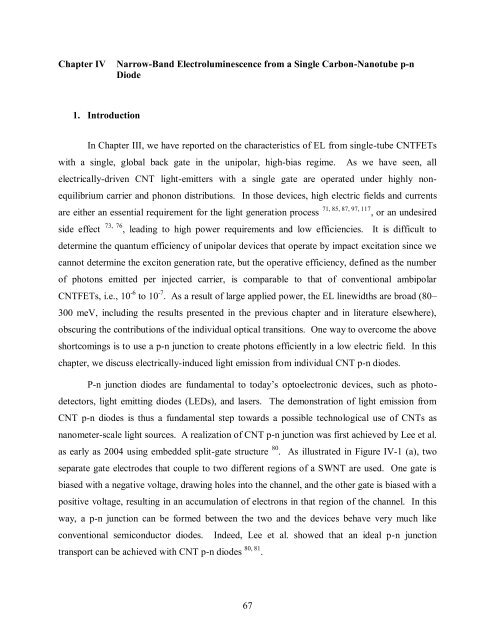Optoelectronics with Carbon Nanotubes
Optoelectronics with Carbon Nanotubes
Optoelectronics with Carbon Nanotubes
Create successful ePaper yourself
Turn your PDF publications into a flip-book with our unique Google optimized e-Paper software.
Chapter IV Narrow-Band Electroluminescence from a Single <strong>Carbon</strong>-Nanotube p-n<br />
Diode<br />
1. Introduction<br />
In Chapter III, we have reported on the characteristics of EL from single-tube CNTFETs<br />
<strong>with</strong> a single, global back gate in the unipolar, high-bias regime. As we have seen, all<br />
electrically-driven CNT light-emitters <strong>with</strong> a single gate are operated under highly non-<br />
equilibrium carrier and phonon distributions. In those devices, high electric fields and currents<br />
are either an essential requirement for the light generation process 71, 85, 87, 97, 117 , or an undesired<br />
side effect 73, 76 , leading to high power requirements and low efficiencies. It is difficult to<br />
determine the quantum efficiency of unipolar devices that operate by impact excitation since we<br />
cannot determine the exciton generation rate, but the operative efficiency, defined as the number<br />
of photons emitted per injected carrier, is comparable to that of conventional ambipolar<br />
CNTFETs, i.e., 10 -6 to 10 -7 . As a result of large applied power, the EL linewidths are broad (80–<br />
300 meV, including the results presented in the previous chapter and in literature elsewhere),<br />
obscuring the contributions of the individual optical transitions. One way to overcome the above<br />
shortcomings is to use a p-n junction to create photons efficiently in a low electric field. In this<br />
chapter, we discuss electrically-induced light emission from individual CNT p-n diodes.<br />
P-n junction diodes are fundamental to today’s optoelectronic devices, such as photo-<br />
detectors, light emitting diodes (LEDs), and lasers. The demonstration of light emission from<br />
CNT p-n diodes is thus a fundamental step towards a possible technological use of CNTs as<br />
nanometer-scale light sources. A realization of CNT p-n junction was first achieved by Lee et al.<br />
as early as 2004 using embedded split-gate structure 80 . As illustrated in Figure IV-1 (a), two<br />
separate gate electrodes that couple to two different regions of a SWNT are used. One gate is<br />
biased <strong>with</strong> a negative voltage, drawing holes into the channel, and the other gate is biased <strong>with</strong> a<br />
positive voltage, resulting in an accumulation of electrons in that region of the channel. In this<br />
way, a p-n junction can be formed between the two and the devices behave very much like<br />
conventional semiconductor diodes. Indeed, Lee et al. showed that an ideal p-n junction<br />
transport can be achieved <strong>with</strong> CNT p-n diodes 80, 81 .<br />
67
















